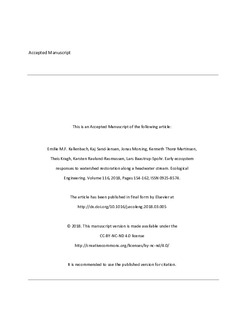| dc.contributor.author | Kallenbach, Emilie | |
| dc.contributor.author | Sand-Jensen, Kaj | |
| dc.contributor.author | Morsing, Jonas | |
| dc.contributor.author | Martinsen, Kenneth Thorø | |
| dc.contributor.author | Kragh, Theis | |
| dc.contributor.author | Raulund-Rasmussen, Karsten | |
| dc.contributor.author | Baastrup-spohr, Lars | |
| dc.date.accessioned | 2018-10-05T07:22:43Z | |
| dc.date.available | 2018-10-05T07:22:43Z | |
| dc.date.created | 2018-03-19T10:31:48Z | |
| dc.date.issued | 2018 | |
| dc.identifier.citation | Ecological Engineering: The Journal of Ecotechnology. 2018, (116), 154-162. | nb_NO |
| dc.identifier.issn | 0925-8574 | |
| dc.identifier.uri | http://hdl.handle.net/11250/2566555 | |
| dc.description | Embargo until 16 March 2020 | nb_NO |
| dc.description.abstract | Along many streams, natural riparian vegetation has been replaced by agricultural fields or plantations resulting in ecosystem alterations due to changes of the interactions across the land-water ecotone. We studied the effect of restoration interventions by removing a dense spruce plantation in a 25 m wide zone along a 4 km section of a headwater stream. Water discharge, nutrient and total organic carbon concentrations were unaffected by the intervention, which only involved 0.7% of the catchment area. Focusing on the oxygen dynamics within several sections of the stream revealed that the stream water was generally oxygen under-saturated both before and after the restoration reflecting the dominance of heterotrophy over photoautotrophy typical of small streams. Oxygen saturation was tightly coupled to water discharge, with anoxia or hypoxia developing during low summer flow, and levels just below saturation during high autumn-spring flow at low temperature and low metabolism. Stream-near felling increased incident irradiance and reduced the duration and extent of summer hypoxia despite unaltered discharge, temperature and concentration of total organic carbon. Increased incident irradiance was accompanied by higher oxygen saturation in open sections compared to control sections with intact tree cover. Diel oxygen changes followed incident irradiance during low summer flow, while alterations at high winter flow were caused by changes in temperature-dependent oxygen solubility and high reaeration. In conclusion, we show that anoxic or hypoxic oxygen levels occur in warm, low-flow summer periods and this stress is reduced when intense shading from spruce plantation is removed and in-stream oxygen production is stimulated. | nb_NO |
| dc.language.iso | eng | nb_NO |
| dc.publisher | Elsevier | nb_NO |
| dc.rights | Attribution-NonCommercial-NoDerivatives 4.0 Internasjonal | * |
| dc.rights.uri | http://creativecommons.org/licenses/by-nc-nd/4.0/deed.no | * |
| dc.title | Early ecosystem responses to watershed restoration along a headwater stream | nb_NO |
| dc.type | Journal article | nb_NO |
| dc.type | Peer reviewed | nb_NO |
| dc.description.version | acceptedVersion | nb_NO |
| dc.rights.holder | © 2018 Elsevier | nb_NO |
| dc.source.pagenumber | 154-162 | nb_NO |
| dc.source.journal | Ecological Engineering: The Journal of Ecotechnology | nb_NO |
| dc.source.issue | 116 | nb_NO |
| dc.identifier.doi | 10.1016/j.ecoleng.2018.03.005 | |
| dc.identifier.cristin | 1573839 | |
| dc.relation.project | Andre: Villum Foundation: VKR022981 | nb_NO |
| cristin.unitcode | 7464,60,0,0 | |
| cristin.unitname | NIVA Danmark | |
| cristin.ispublished | true | |
| cristin.fulltext | original | |
| cristin.fulltext | postprint | |
| cristin.qualitycode | 1 | |

